Account-based marketing (ABM)—a strategic approach that focuses on targeting and engaging specific high-value accounts—has been around as a concept since the early 2000's. Now, its popularity is skyrocketing as modern technology is making it easier for small companies to implement.
But if you want all the ABM benefits like better sales-marketing alignment and larger deals, you need the right account-based marketing campaign. In this article, I’ll cover more thoroughly what ABM is and its benefits, then show you exactly how you can craft the ideal ABM strategy for your company.
What is Account-Based Marketing and Why Should You Care?
Account-based marketing is a strategic marketing approach where you focus on a few target accounts (potential clients) and appeal to those accounts through personalized marketing campaigns.
When implemented right, an ABM approach can help you grow your marketing-generated revenue by saving you from the "spray-and-pray" method.
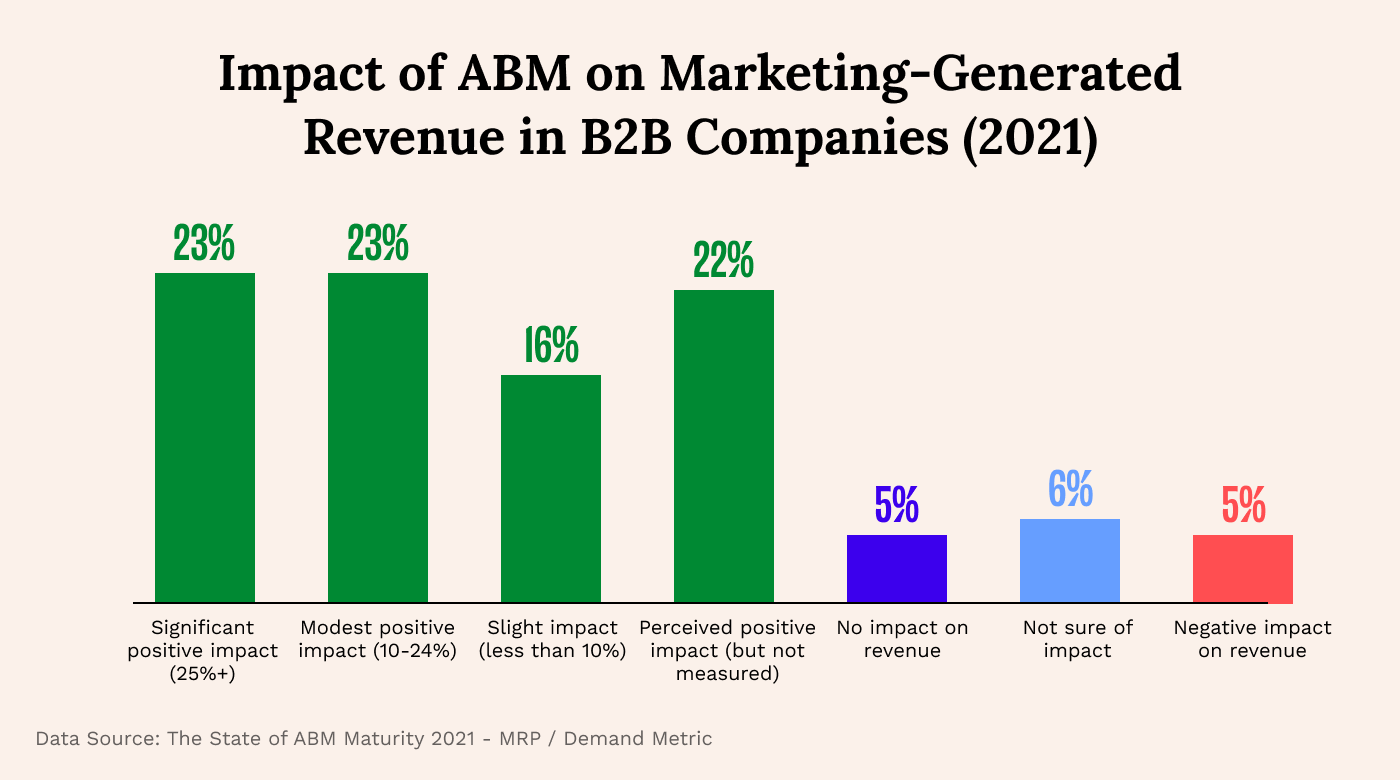
According to Market Resource Partners, 84% of B2B marketers reported driving more revenue after making the switch to ABM. Call me hyperbolic, but I’d say that’s a pretty clear indicator that ABM might not be such a bad idea.
But rather than the end-of-the-line result of increased revenue, what are the concrete changes and benefits of adopting ABM? Let’s take a closer look.
Benefits of Account-Based Marketing
Adopting account-based marketing ideas can help B2B companies drive more revenue thanks to benefits like more engagement with target accounts, pipeline growth, increased deal size, and better sales-marketing alignment.
But I don’t expect you to just take my word for it, so let’s look at the data.
The 2022 ABM Benchmark Study by Momentum ITSMA and the ABM Leadership Alliance backs up many of the benefits that I mentioned above:
- 90% of companies experienced more active engagement with decision makers in target accounts.
- 84% of B2B marketers reported seeing significant pipeline growth.
- 72% reported a better return on investment.
Sales and marketing alignment, a key benefit of ABM, is also well documented. Seventy-five percent of B2B marketers surveyed by Demand Spring in 2022 reported an increase in sales and marketing alignment after switching to ABM.

With benefits and ABM examples like this, it’s easy to see how it helps your sales and marketing teams close more deals, boosting your bottom line.
I could keep going, but since this is a strategy guide, it’s time to stop waxing lyrical about ABM’s benefits and show you how to actually get your ABM strategy up and running. If you still want to learn more, try listening to our recommended account-based marketing podcasts.
How To Craft Your Account-Based Marketing Strategy in 7 Steps
To lock down potential benefits like better sales-marketing alignment and more revenue, follow the steps I've outlined below. And don’t worry, we’ll cover tracking and attribution too, so you can see the results of your change to ABM.
1. Choose Your Targeting
The first thing you need to consider when you’re adopting ABM is the type of account-based marketing tactics and campaigns that you’ll pursue.

- Strategic ABM is what most people think of when they hear ABM—campaigns that are designed with specific companies and personalized to specific people within those companies. It’s also called one-to-one ABM because you’re designing marketing with a single company, and often, a single decision maker in mind.
- ABM Lite is when, instead of committing 100% to a personalized approach for each company and contact, you group together similar “clusters” of companies. Then you create campaigns to target these clusters instead of one account at a time.
- Programmatic ABM is a sort of mix between ABM and typical “push” campaigns where you’re relying on a wide media-driven reach. But there’s no waiting and hoping. You actively track engagement and interactions from target companies. Then, you have the marketing-sales alignment to actively help your sales rep follow up with the right leads at the right time.
While you should consider your options (and all three are viable in different scenarios), keep in mind that 73% of ABM leaders from that 2022 ABM Benchmark Study used one-to-one ABM.
2. Get Sales and Marketing Buy-In
As a marketing manager or CMO, you know first-hand how hard it is to get your employees to follow through on even simple changes like a new protocol, or a switch in marketing analytics software.
So you understand that getting buy-in from your sales, marketing, and (if you have them) customer success or revenue teams is crucial. A misaligned sales and marketing team is a common account-based marketing mistake that ends in disaster.
But how do you do that?
The first step is to include key members from all teams from the very beginning of the process. Employees often react poorly to top-down decisions without their input. Solution? Start the entire ABM transition process with a brainstorming session or workshop where managers and a few members of each relevant team are present.
You can use a variety of different project management and meeting formats for this process, but I’ve seen positive results from an Agile marketing approach, and the data seems to agree with me.
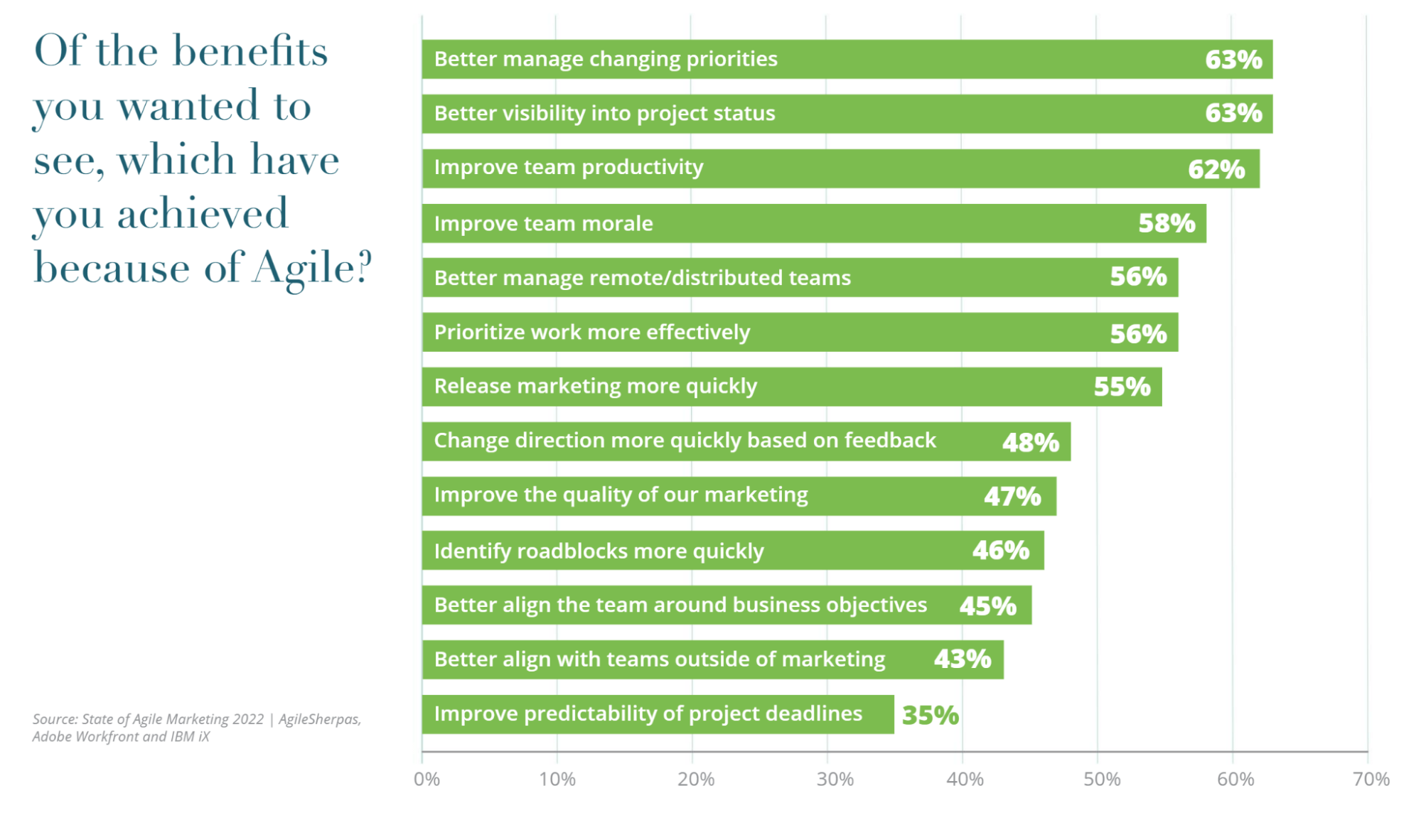
Agile marketing teams are better at managing changing priorities, maintaining morale, and changing direction quickly based on feedback.
Try to instill Agile principles like:
- Putting people and interactions above tools and rigid processes
- Responding to change rather than sticking to a plan
Should you do a full Agile transition as you’re transitioning to ABM? Probably not, but a flatter and more flexible structure and culture can do wonders for morale and fast implementation.
3. Put Together Your Ideal ABM Team
When you’ve decided to revamp your entire marketing and sales approach, the last thing you want to do is add too many new hires to the mix.
According to LinkedIn, a single new hire takes on average 38 days in sales, and 40 days in marketing. So not only can it delay the initial stage of the transition to ABM, but it can also make it less likely to succeed in the long run.
Why? New hires take a long time to adapt to the situation, values, and environment in a new company. In fact, 76% of companies estimate it takes four months or more before new hires start adding value, and you don’t want to be stuck in limbo waiting for newbies to start pulling their weight.
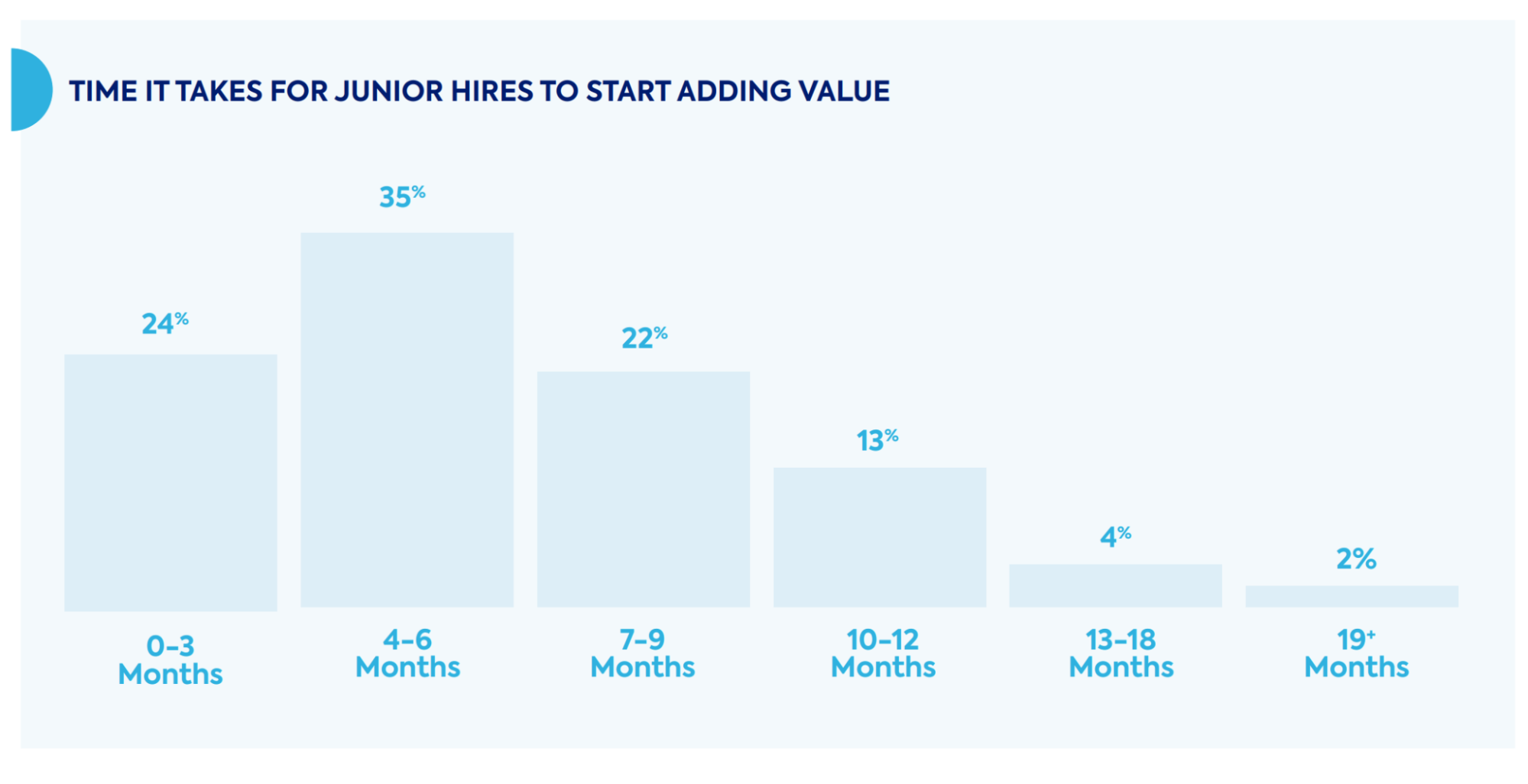
Instead, include employees who are already familiar with your company and its underlying processes and can help you adapt to ABM faster and more thoroughly. So, who exactly should you include in the team?
Here’s an example of what the ABM transition team might look like.
- Relevant sales manager
- Marketing manager
- Customer success manager
- Marketing and sales analysts
- 1–2 Experienced sales reps
- 1–2 Experienced account managers
- 1–2 Experienced sales development reps (SDRs)
Note that this is a temporary ABM adoption team, as the end goal is to make ABM the status quo for the entire sales and marketing departments.
If you’re making the transition in a larger company, it’s important to follow these change management best practices for ABM. Don’t underestimate things like:
- Maintaining an active and clearly visible executive sponsorship
- Following a structured change management approach with clear milestones
- Including and cooperating closely with middle management
- Use tools to automate processes that would otherwise hinge on a potential bottleneck
- Communicating often, with clarity, and without fluff
It’s a significant transition with plenty of room for things to not go according to plan. The key to success is dedication to the switch from all levels, C-suite, middle management, and the employees themselves.
4. Invest in the Right ABM Software
You might be wondering what this is doing as part of a strategy guide, but the account-based marketing software you decide to invest in plays a crucial role in how you’re going to be able to implement your strategy.
For example, if you’re going to do ABM Lite or Programmatic ABM, you need software that lets you track target account engagement touch points like website visits. Otherwise, your sales won’t get the insights they need to personalize their approach based on the effects of your digital marketing campaigns (which is the whole goal of those types of ABM in the first place).
Here’s an example from Demandbase of the kind of data you can leverage:
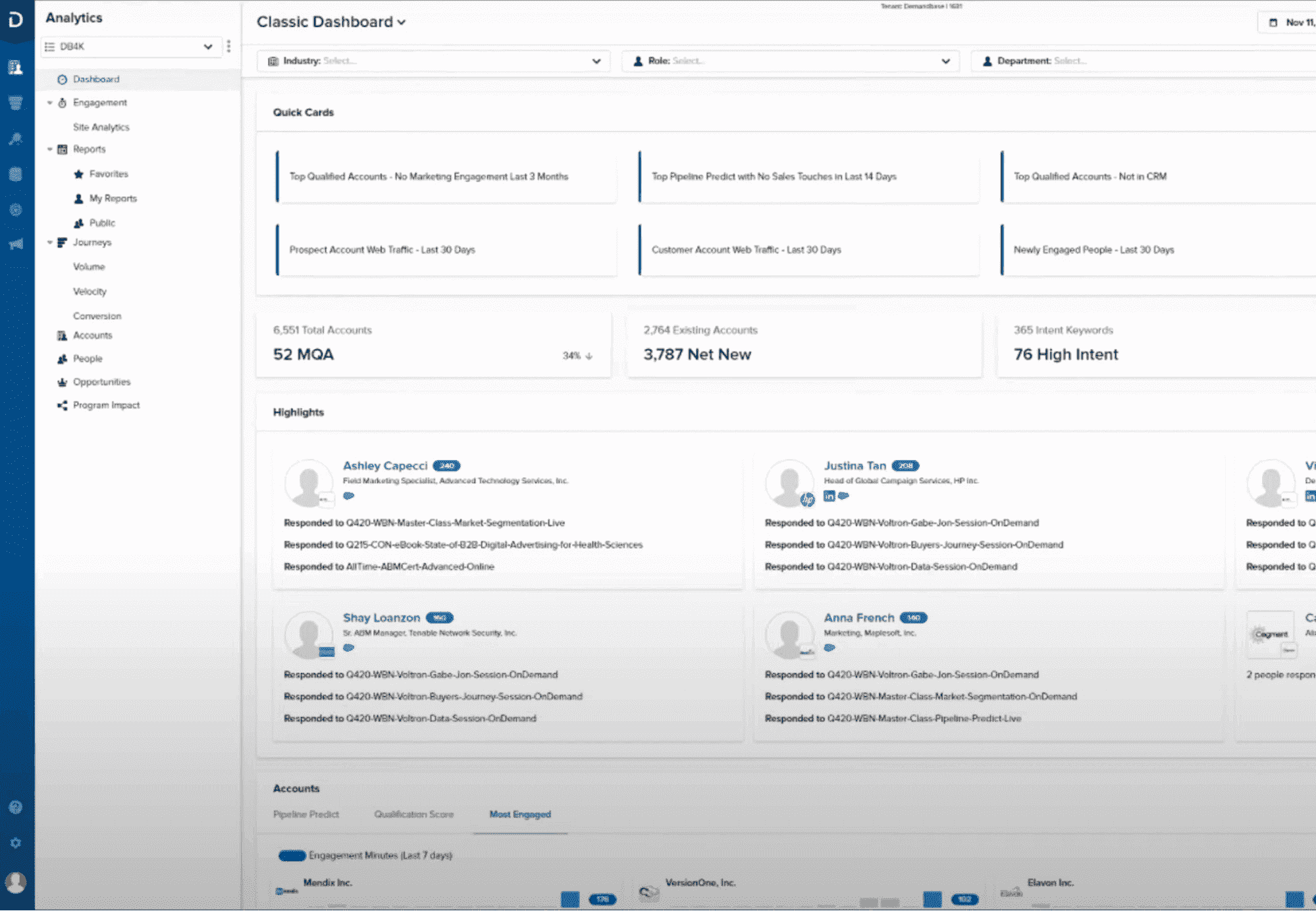
You can break down specific target accounts by exactly what actions they’ve taken on your site (or on other channels like social media).
Of course, for these types of insights to matter, your sales reps also need to be active in the same software. That’s why having ABM evangelists in both camps is so crucial.
Another key consideration is the type of company account intelligence data available in the software for prospecting purposes.
For example, if you’re a SaaS business, you probably want “technographic” data on the tech stack of potential customers. With it, you can check, for example, whether they’re using a competitor or if they use CRM software that your product integrates with.
If your approach is more hands-on, you’d probably prefer a solution with solid general firmographic data on companies in your area.
Don’t be afraid to add to your ABM tech stack throughout the research process as you discover the need for new data or features. It’s better to pay more to start in the right direction than to initiate an expensive ABM campaign targeting the wrong accounts—especially since 74.6% of B2B sales cycles take at least four months to complete, according to a report by CSO Insights.
5. Determine Your Ideal Clients
After getting your broad strategy, team buy-in, and software in check, it’s time to research and figure out which companies you should be targeting.
Luckily, for most companies, this no longer means mindlessly staring at spreadsheets for days (or having to subject your employees to this cruel and unusual punishment). With a wide array of customer data on tap in your CRM or other platforms, you can typically drum up a relevant report that gives you the data you want with a few clicks.
Here are a few reports that come to mind that should make up the foundation of your future target account selection:
- Customer lifetime value reports to find your most valuable customers (both sorted by highest value per annum and in total)
- Sales velocity reports to identify your most eager customers
Depending on your CRM and the data you’ve chosen to include in your customer profiles, look for patterns in firmographic data such as industry and company size, technographic data, and other factors while examining the reports.
If you don’t have this data on hand, you have to research the companies and identify these patterns manually (happy Googling).
Use the patterns you discover across different categories to create an ideal customer profile (ICP) to guide your future ABM campaigns.
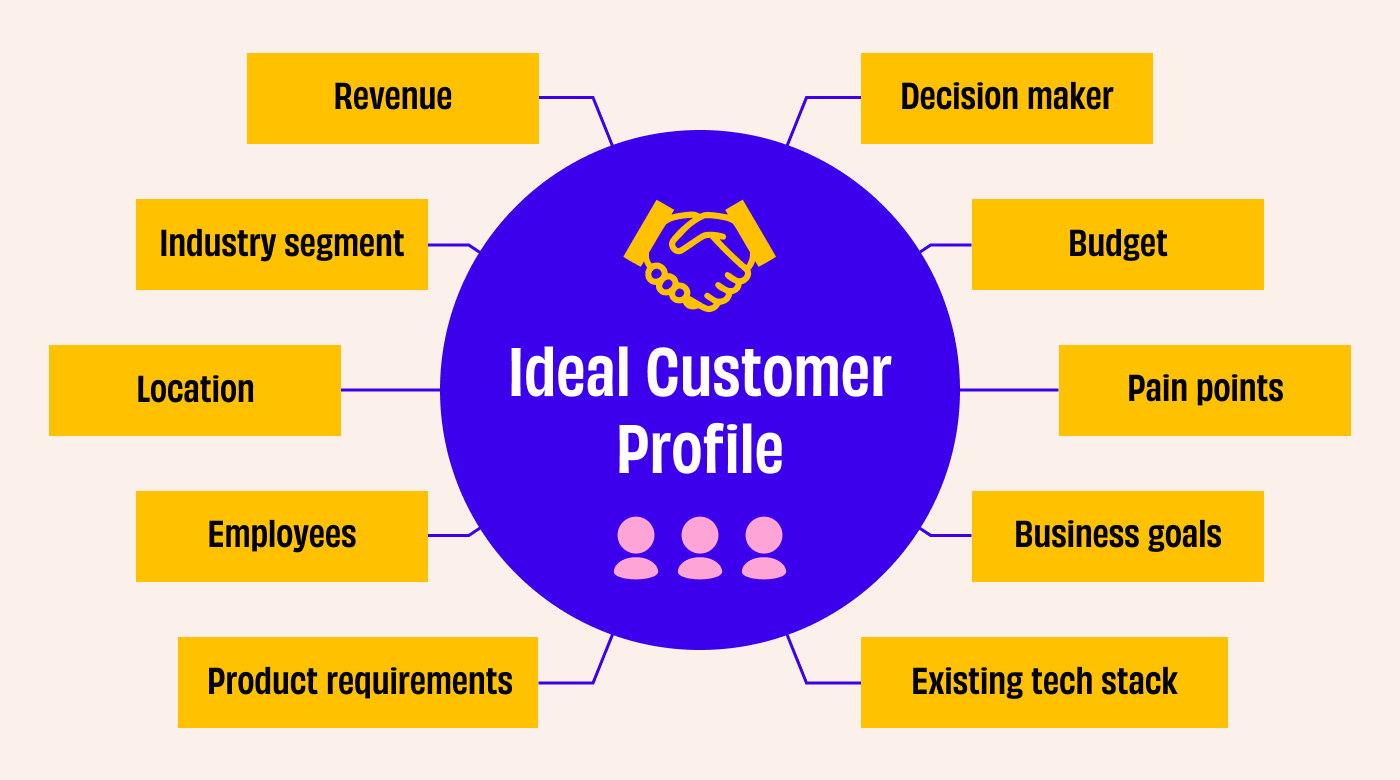
Here are a few of the data points that a typical ICP includes:
- Company size: Annual revenue, number of employees
- Location: Country, state, or even more narrow depending on your product/service
- Budget: Their estimated budget for a solution like yours
- Decisions-makers: Various levels of employees that can directly influence a buying decision on your specific offering
- Business goals: What the companies want to achieve (especially goals that are directly relevant to your offering)
- Pain points: What’s stopping your ideal customers from achieving their goals?
- Product requirements: What are absolute musts in this specific product/service for these types of companies? (If they’re an enterprise, it could be uptime SLAs, access management, data security tools, etc.)
- Existing tech stack: Are they already using competing products? Do they have the required foundation to even be able to use your solution?
As part of my ABM marketing strategy template (keep scrolling to find this below), I’ve included a complete ICP template to give you a starting point.
The ICP is one of the foundational guiding documents in your ABM strategy, so take your time during this stage.
The whole point of switching to an ABM framework is for your marketing efforts to be more targeted. If your campaigns are directed in the wrong direction through lazy research or bad data, you’ll only reach uninterested buyers (not exactly an upgrade from reaching mostly uninterested buyers through a typical push campaign, is it?)
6. Figure Out the Right ABM Channels to Reach Your Target Accounts
It’s not enough to just decide on which companies would make good clients. How are you going to reach these target accounts for the best account-based experience?
While the focus of B2B used to be on direct outreach, the landscape has changed to include a wide mix of digital channels:
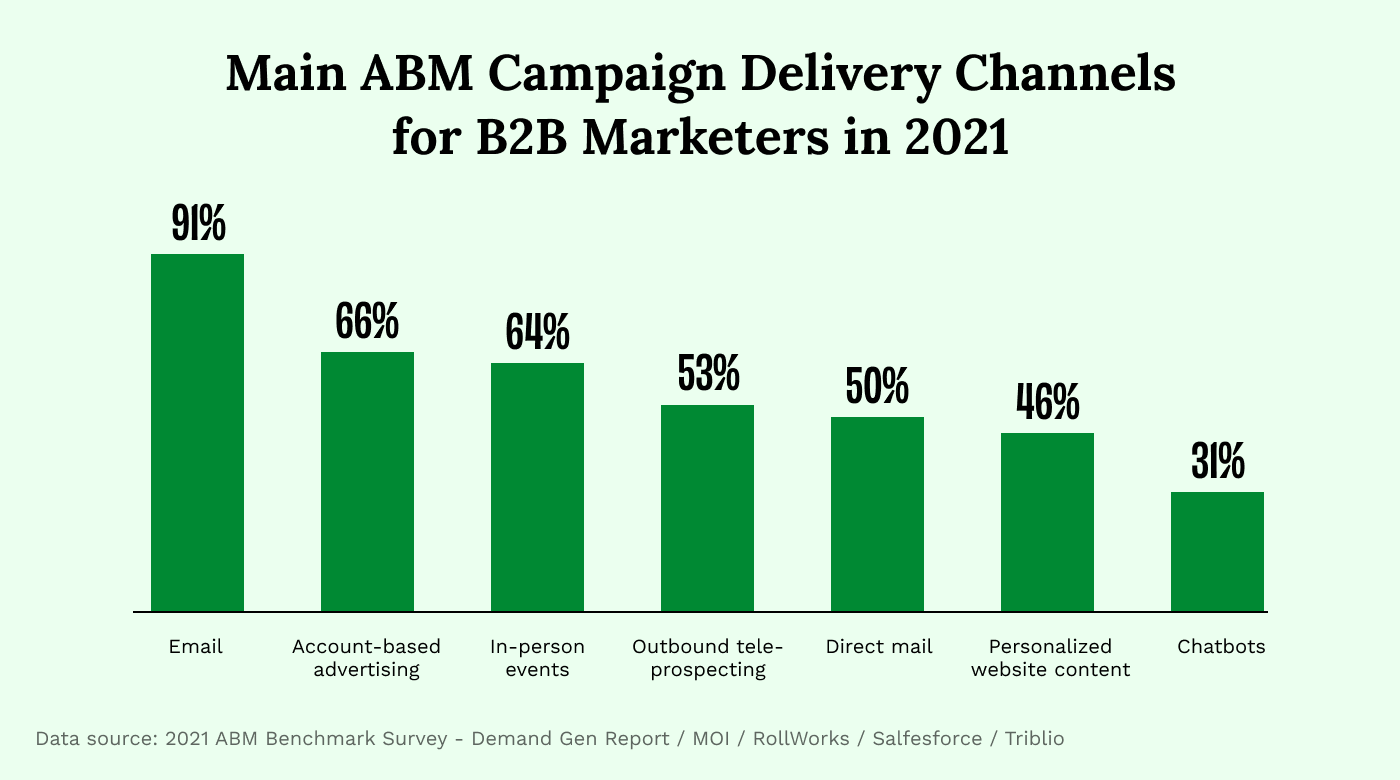
- Email was the most popular delivery channel for ABM campaigns in 2021, with 91% of B2B marketers taking advantage of it.
- Account-based advertising came in second with a 66% usage rate.
- In-person events, at 64%, show that the hands-on approach is still crucial in B2B today.
- Tele-prospecting is also still a big part with 53% adoption.
- Direct mail, at 50%, is also a crucial weapon in the arsenal of a modern B2B marketer.
Finding the right marketing mix for your company will depend on three factors:
- The preferences of your target audience—where would they prefer to be reached? A TikTok campaign isn’t exactly the best way to reach the average C-level executive.
- The scale of your approach (programmatic ABM vs. strategic ABM for example).
- Your budget and the capacity of your team and martech stack examples you want to emulate.
One of the best ways to get a feel for which channels are ideal for your target accounts is to hand-pick a few key accounts to do a manual deep-dive on. You want to answer the following questions:
- Where do key decision makers spend their time online?
- What types of content do they tend to engage with?
- Where are your competitors focusing their budget and energy?
- How can you stand out from the competition in a meaningful way?
Once you’ve figured that out, you can start designing your own marketing mix.
LinkedIn is a cliche for B2B digital campaigns at this point. It’s a good starting point, but it’s not the end-all-be-all. Make sure you also consider trusted industry publications, industry influencers, partnerships with adjacent providers, and more.
Are your competitors only focusing on broad programmatic campaigns? Impress C-level executives with a personal touch—use account-based advertising to deliver content tailored to their needs (and address them by name).
7. Use Attribution Reports to Track Results and Optimize Your Approach
What sets a successful ABM strategy apart from one that fails isn’t necessarily the difference in the initial effort, it’s the willingness to continue improving it after you’ve started your first ABM campaigns.
But to be able to make such changes with confidence, you need data to back up those decisions.
According to Capgemini, change management projects are 27% more likely to succeed if the company has a high level of data maturity.
Even if you’ve already invested in a complete ABM platform (Demandbase, 6sense, Hubspot ABM, Marketo Engage, etc.) you need to ensure you’ve integrated various sources of customer data: your CRM, website analytics, email marketing software, and more.
Account-Based Marketing Strategy Template To Help You Get Started
I realize that this is a lot of information to take in at once (3,000 words and counting in this guide alone). So I’ve created an ABM strategy template you can follow along and use as a guide for your ongoing transition.
It includes a complete ideal customer profile template, as well as sections to fill out for each of the other sections (along with instructions and example data).
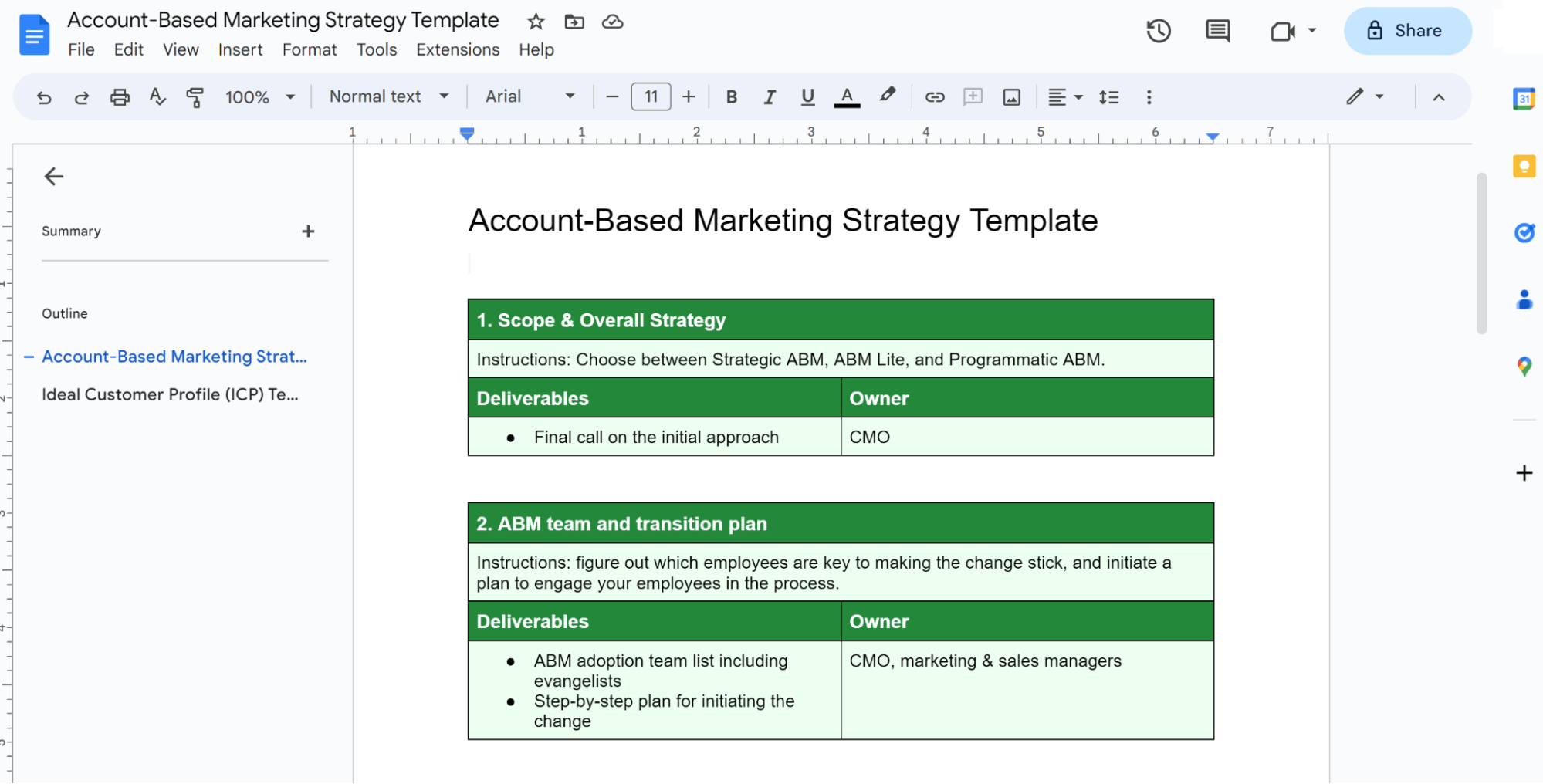
To get the most out of this guide, I recommend that you don’t try to randomly fill it out as you’re reading this alone, but that you:
- Copy the template into a new doc
- Invite the members of your ABM transition team
- Fill it out together as the first step to initiate the process
I’ve also included suggested deliverables (like target accounts lists) along with a field to assign a deliverable owner to each of these fields.
Adopting an ABM strategy isn’t just about learning new marketing and sales principles. It’s about getting your marketing and sales teams to apply these principles throughout every campaign, every single day.
That’s why having a single shared strategy document that everyone involved can access—and that you can use for onboarding—is crucial.
Send this guide to your team, set a date for the ABM transition launch meeting, and fill it out to start the process the right way. You'll probably also need an ABM campaign template to measure progress.
Perfect Your ABM Strategy
ABM is often pitched as the end-all-be-all solution to your B2B marketing problems, but in the end, it’s a modern framework that’s only as good as you make it.
You have to figure out the right strategy and targeting based on your product, industry, pricing, market position, competition, and a variety of other factors. Sounds just like standard B2B marketing, right?
So on paper, it’s not a revolutionary change. Where the real difference shows itself is in the everyday actions taken by your sales and marketing staff. Instead of designing broad campaigns, your marketers will create personalized ads for key accounts, and instead of calling endless lists by area, your SDRs will focus on specific people in specific companies.
So it’s important to include a certain level of detail within the strategy itself. The only way to get this right is to keep working at it over time—like continuously updating and sharing your strategy through Google Docs.
To keep evolving your marketing with expert tips, proven techniques, trends and hand-picked lists of recommended tools, sign up for the CMO newsletter.


